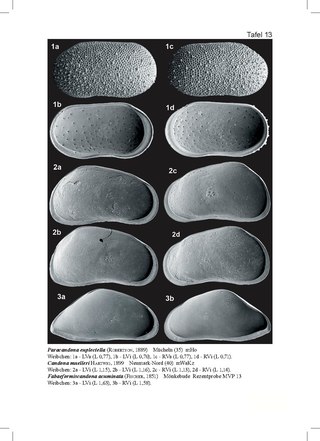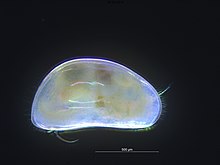
Ostracods, or ostracodes, are a class of the Crustacea, sometimes known as seed shrimp. Some 33,000 species have been identified, grouped into 7 valid orders. They are small crustaceans, typically around 1 mm (0.04 in) in size, but varying from 0.2 to 30 mm in the case of the marine Gigantocypris. The largest known freshwater species is Megalocypris princeps, which reach 8mm in length. In most cases, their bodies are flattened from side to side and protected by a bivalve-like valve or "shell" made of chitin, and often calcium carbonate. The family Entocytheridae and many planktonic forms do not have calcium carbonate. The hinge of the two valves is in the upper (dorsal) region of the body. Ostracods are grouped together based on shell and soft part morphology. While early work indicated the group may not be monophyletic and early molecular phylogeny was ambiguous on this front, recent combined analyses of molecular and morphological data suggested monophyly in analyses with broadest taxon sampling, but this monophyly had no or very little support. They have a wide range of diets, and the class includes carnivores, herbivores, scavengers and filter feeders, but most ostracods are deposit feeders.

Cylindroleberididae is a family of ostracods that shows remarkable morphological diversity. The defining feature is the possession of gills: 7–8 leaf-like pairs at the posterior of the body. Other features common to all species in the family include a "baleen-comb" on both the maxilla and the fifth limb, a sword-shaped coxal endite on the mandible, and the triaenid bristles on the basal endites of the mandible.

The Podocopa are a subclass of ostracods. Members of the subclass Podocopa can be differentiated from the other subclass of ostracods (Myodocopa) by the morphology of the second antenna: the Podocopa have a relatively long endopod, whereas the Myodocopa have a relatively long exopod. The seventh limb of the Podocopa has a variety of forms or is absent, but is never an annulated worm-like limb.

The Podocopida are an order of ostracods in the subclass Podocopa. It is the most diverse of the five orders of ostracods, and the only one with freshwater species. The group also has a rich fossil record.
Limnocythere is a genus of ostracod crustaceans in the family Limnocytheridae. It contains the following extant species :
Liocypris grandis is a species of ostracod which was long presumed extinct. It was rediscovered in the Western Cape of South Africa in 2003, having not been seen since its original description by Georg Ossian Sars in 1924. It was assessed as extinct for the IUCN Red List in 1996, and that assessment has not been updated.
Newnhamia is a genus of ostracods. It contains five species, four of which are endemic to Australia and surrounding islands, while a fifth was described in 2003 from Kerala, India. Two species from South America, described as species of Newnhamia, do not appear to be closely related to the remaining species, and probably belong in a different genus. N. fuscata and N. insolita are both listed as vulnerable species on the IUCN Red List.
Pseudocandona is a genus of ostracods in the family Candonidae, containing the following species:
Typhlocypris cavicola is a species of ostracod crustacean in the family Candonidae. It is endemic to Slovenia, where it is only known from Krka Cave.
Typhlocypris trigonella is a species of ostracod crustacean in the family Candonidae. It is endemic to Slovenia, where it is known only from Postojna Cave.

Cypridinidae is a family of ostracods. About half of all known species are bioluminescent. Some use the light only for defence, others also for courtship displays. The linages with sexually dimorphic bioluminescent displays have more species other linages, which indicates that bioluminescent courtship could increase the diversification rates.
Cytherellidae is the only living family of the ostracod order Platycopida. Eyes are absent. It contains 11 genera:

Cyprididae is "the most diverse group of freshwater ostracods". It contains over 1000 species, which represents 50% of the known species of freshwater ostracods. Around 60% of genera in the family are endemic to a single zoogeographic region. The family contains 16 subfamilies, and is most diverse in the Afrotropical realm, with over 300 species in 45 genera. Many Cyprididae occur in temporary water bodies and have drought-resistant eggs, mixed/parthenogenetic reproduction and ability to swim. These biological attributes pre-adapt them to form successful radiations in these habitats. Bennelongia is an interesting of the family Cyprididae. It may be the last true descendant of the Mesozoic lineage of Cypridea, which was a dominant lineage of ostracod in non-marine waters in the Cretaceous.
Limnocytheridae is a family of ostracods, containing the following genera:
Bennelongia is a genus of ostracod crustaceans in the family Cyprididae. It is probably endemic to Australia and New Zealand, and is predicted to be highly diverse. The genus was described in 1981 and named after Woollarawarre Bennelong, the first aboriginal to have a long association with the early European settlers of Australia. Prior to 2012, six species were described in Australia. There are currently 15 species of Bennelongia. Bennelongia may be the last true descendant genus of the Mesozoic lineage of Cypridea, which was a dominant lineage of ostracod in non-marine waters in the Cretaceous.
Azygocypridina is a genus of ostracods in the family Cypridinidae, which appears to be "the least derived living ostracod", having remained largely unchanged for 350 million years. It contains the following species:

Candona is a genus of ostracods in the family Candonidae.
Chlamydotheca is a genus of freshwater ostracods in the family Cyprididae. About 36 species are known to occur throughout continental waters. Four species are found in Argentina.

Macrothricidae is a family of anomopods in the order Diplostraca. There are about 17 genera and at least 80 described species in Macrothricidae.
Areacandona yuleae is a species of freshwater ostracod crustacean in the family Candonidae. It was originally described in 2007 from specimens collected from the Pilbara region in Western Australia, by Ivana Karanovic.






